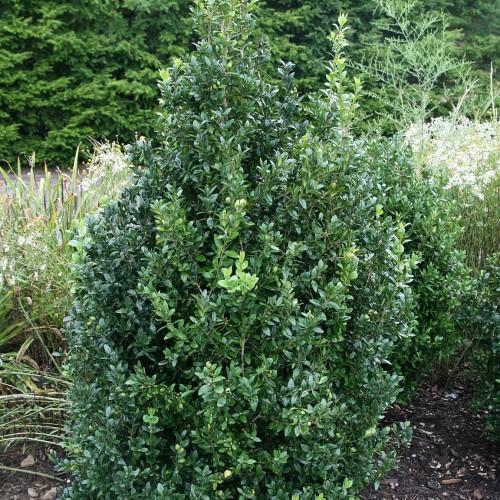
boxwood
Buxus sempervirens 'Rochester'
Cycle:
Perennial
Watering:
Average
Hardiness Zone:
5 - 8
Flowers:
Flowers In Spring
Sun:
Deep shade, Filtered shade, Full sun only if soil kept moist, Part sun/part shade
Soil:
Alkaline, Well-drained
Fruits:
Fruits In Summer Ready In Fall
Leaf:
Yes
Growth Rate:
Moderate
Maintenance:
Moderate
watering
Boxwood (Buxus sempervirens 'Rochester') should be watered once a week, allowing the soil to get slightly dry before re-watering. The amount of water should be enough to moisten the entire root system, but should be limited so that you do not see standing water in the pot. Consistent moisture is important, but it is best to gradually reduce the amount of water during periods of cooler temperatures. If the leaves of your boxwood are wilting, it is a sign that it needs additional water.
sunlight
Boxwood (Buxus sempervirens 'Rochester') is a member of the Buxaceae family and is a shade-tolerant evergreen shrub. It prefers sites with partial to full sun exposure and should get about 4 to 6 hours of direct sunlight a day for optimal growth and health. This usually translates to morning sunshine and partial afternoon shade. Too much direct midday sun can cause leaf scorch. During hot summer months, it is beneficial to provide some afternoon or dappled shade.
pruning
Pruning boxwood (Buxus sempervirens 'Rochester') is best done during the late spring or early summer months. Avoid pruning during periods of extreme heat or extreme cold. Generally, boxwood should receive a light trim each year to maintain a desired shape and size. During this trim, remove weak or dead branches and thin them by removing a few of the older stems, allowing new branches to soar and creating light within the shrub. If you are looking to reduce the size of a boxwood, you can do a more aggressive pruning, removing 1/3 to 1/2 of the shrub’s oldest branches and stems. Make sure you are making clean cuts as to not tear at the boxwood.
Season
Hardiness Map
FAQ
Is Boxwood a popular landscape plant?
Yes, Boxwood is a popular landscape plant, due to its versatility in design, hardiness in cold temperatures, attractive foliage and its ability to be pruned into a variety of shapes. It makes an attractive year-round hedge, foundation plant or edging and, if left unpruned, can be grown as a small tree or shrub. Boxwoods can be planted either in the sun or partial shade and are a great addition to gardens of any size.
Are Boxwoods evergreen?
Yes, boxwoods are evergreen. They have deep green foliage and remain an attractive evergreen tree year-round, allowing for a versatile way to add color and structure to outdoor spaces. Boxwoods are also extremely easy to grow, making them a great choice for novice gardeners. Additionally, boxwoods are relatively low maintenance and can handle some light pruning if needed.
Can Boxwoods be trimmed into shapes?
Yes, boxwoods can be trimmed into shapes. With regular maintenance and occasional pruning, they can be cut and shaped into hedges, topiary, round forms and other creative patterns. Pruning them regularly also ensures that they remain healthy and look their best. It is important to trim them with the right tools and techniques in order to keep them healthy, while also achieving the desired shape.
Could Boxwoods be used as a hedge plant?
Yes, boxwoods can be used as a hedge plant. They are low-maintenance, evergreen shrubs that can be trimmed to create uniform hedges or shaped into topiary. Boxwoods are also resistant to disease and can tolerate both full sun and partial shade. They are ideal for small to medium hedges and make an attractive backdrop for annual and perennial flowers.
Should Boxwoods be planted in full sun or shade?
It depends on the variety of boxwood you have. Some varieties, such as English boxwood, are best planted in full sun for optimal growth and form. However, other varieties such as American and Korean boxwood do better in partial shade due to the more intense heat of full sun. In areas with long, hot summers and mild winters, provide some shade protection to prevent over-heating and drying out, especially during the hottest times of day.
